Bug Out Vehicle Guide, Gear List, and Checklist
A bug out vehicle, also known as a BOV or survival vehicle, is a vehicle that is designed to help its occupants quickly evacuate an area in the event of an emergency or disaster. BOVs typically have a number of features that make them well-suited for this purpose, such as large storage capacity, off-road capabilities, and durability.
In this article we will take a closer look at some specific bug out vehicles, key features to consider when choosing one, and a common checklist to gear it up and get it going.
Contents (Jump to a Section)
What is a Bug Out Vehicle
A bug out vehicle (BOV) is a type of vehicle that is specifically designed to help its occupants quickly and safely evacuate an area in the event of an emergency or disaster. This could be anything from a natural disaster like a hurricane or earthquake to a man-made disaster like a terrorist attack or civil unrest.
The goal of a BOV is to provide its occupants with a means of transportation that is reliable, durable, and capable of handling a variety of different terrains and road conditions. BOVs are typically larger and more rugged than the average passenger vehicle and are often equipped with a number of specialized features that make them well-suited for emergency situations.
Features of a BOV
One of the key features of a bug out vehicle is its storage capacity. BOVs are designed to be able to carry large amounts of gear and supplies, which can be essential in an emergency situation. This could include things like food, water, medical supplies, tools, and other essential items.
Another important consideration for a BOV is its off-road capabilities. In an emergency situation, it is likely that roads and highways will be congested, damaged, or blocked, making it necessary to take alternative routes. A BOV should be able to handle a variety of different terrains, including dirt roads, muddy trails, and rocky terrain.
In addition to its storage capacity and off-road capabilities, a BOV should also be durable and reliable. In an emergency situation, there may not be the option to call for help or to get roadside assistance. Ideally, a BOV should be able to withstand rough treatment and should be able to continue running even if it sustains damage.
Types of Bug Out Vehicles
There are a number of different types of bug out vehicles to choose from, each with its own unique set of features and capabilities.
The most common types of BOVs include:
- Sport Utility Vehicles: SUVs are popular choices for BOVs due to their combination of size, storage capacity, and off-road capabilities. Many SUVs are also equipped with four-wheel drive, which can be essential for navigating rough terrain.
- Pickup Trucks: Pickup trucks are another popular choice for BOVs, due to their large storage capacity and off-road capabilities. Many pickup trucks are also equipped with four-wheel drive, which can be useful in emergency situations.
- Vans: Vans can be a good choice for BOVs due to their large storage capacity and ability to transport multiple people. Some vans are also equipped with four-wheel drive, which can be useful in off-road situations. Check out our entire guide on Bug Out Vans.
- Military Vehicles: Military vehicles are designed to be rugged and durable, making them well-suited for use as BOVs. Some popular choices include the Humvee and the MRAP.
- Recreation Vehicles (RVs): RVs come in a wide range of sizes and with a wide range of options. Being mobile homes on wheels makes them a solid choice for living on the go, even in an emergency. Some plan on an RV being both the bug out vehicle and the bug out location.
Regardless of the type, having a vehicle ready is a smart part of your overall bug out plan.
Other BOVs
Less common bug out vehicles can make sense for specific situations. Here are the options preppers have explored:
- Aircraft: On the pricey side of things, any type of aircraft can get you to your bug out location quickly.
- Boats: Like aircraft, boat travel can be restrictive but is much more affordable. If you are near the coast or a body of water, a boat could be a good vehicle option. With the variety available some preppers plan on using these:
- House Boat: These sustainability barges can be pretty comfortable as a secluded bug out location when they are built out properly.
- Collapsible Boats: Inflatable John boats and foldable kayaks are the go-to here, for people near water but don’t want the maintenance and responsibilities of owning a boat with an actual hull.
- Bikes: A popular bug out vehicle for urban areas also works quite well in grid-down or EMP situations. With saddlebags and/or trailers you can take a lot of equipment with you as well. Bikes can maneuver where cars cannot and are sustainably human-powered so gas or electricity does not have to be an issue.
- Motorcycles: Many times, carburated motorcycles are picked as bug out vehicles because of EMP resiliency and a motorcycle’s ability to maneuver between gridlocked traffic.
- Sedans: Cars are not the best pick for a bug out vehicle, but if it’s what you have you can make it work.
Bug Out Trailers
Having your bug out vehicle as a daily driver can be cumbersome, so some preppers opt to offload their gear into a bug out trailer. When they need to bug out they hook up the trailer which is smart and quick.
No need to pack up tons of bags and bins- it’s all preloaded. Plus, this lets you declutter your actual vehicle for everyday use. Bug out trailers make a lot of sense the more you think about it.
Bug Out Electric Vehicles (EVs)
This is one I’m personally planning out with a Tesla Model 3. There are many drawbacks to using an EV as a bug out vehicle (range, off-road capability) but they have some under-sold benefits as well. In my family, we could bug out both the EV and the SUV, but if we bug in (stay in place)- which we are more than prepared to do- the Tesla becomes a massive battery pack.
The base Model 3 I have has a 60 kWh 106 cell 400V Lithium Ion pack in it ready to power whatever when I put the vehicle in ‘camp mode’. Tesla discourages using it as a ‘stationary power source’ and voids the warranty if they find out but other EV manufacturers have been touting their ability to power odds and ends.
EVs also can be charged with any electrical source: from solar panels to dual fuel generators. Combustion cars have to seek out or store gasoline or diesel, whereas electricity is much easier to come by in the modern world.
The last drawback to EVs is the threat of an EMP. EMPs would disable many modern cars, but an EV is guaranteed to be a paperweight. I’ve considered constructing a giant Faraday bag for my Model 3- more of an experiment than anything. Unfortunately, the materials to construct it cost at least $1,000 so that’s an experiment I can’t afford for now.
EMP-Proof Bug Out Vehicles
Like we just mentioned with EVs, a Nuclear EMP can damage vehicle electronics, especially microchips. While it’s not guaranteed to fry your 2002 Camry, most vehicles since the late 1980s have sensitive circuitry that can be damaged by overvoltage.
And overvoltage is exactly what a HEMP does when it splashes the atmosphere in a high-altitude burst – wires act as antennas for the energy pulse and carry large currents into circuit boards and microchips damaging them. It hasn’t been tested, but most scientists believe this is a likely scenario and the military hypothesis on this subject is still classified.
One reason EMPs are so low on our own risk evaluation is because of their implication. An EMP would almost certainly be a precursor to nuclear war- a risk with an even higher impact! One of our favorite books on this, the popular One Second After overlooks this probability so it can detail post-EMP life in America.
Scam Alert: EMP Shield and T.R.A.P. EMP Vehicle Protection won’t work for an actual Nuclear EMP. Cables that are not voltage cables would also have a large current pushed during the E1 pulse of a HEMP, resulting in damaged components regardless.
Protecting a car’s electronics from 50 volts/meter isn’t really feasible, and experts say the best protection is avoiding having your car exposed to 50 volts/meter.
This is why if you really need to EMP-proof your vehicle, the only proven options are Faraday cages. You could construct your own Faraday bag and slip it over your car, but the materials would cost you close to $1,000. Constructing a Faraday cage garage would cost even more, but some people do it.
Having older cars helps, but isn’t a fail-safe guarantee. We do know that regardless of the car’s make, model, or year, a sealed Faraday cage can protect it.
Bug Out Vehicle Checklist
A bug out vehicle contains at least as much as your standard vehicle survival kit but has several other supplies to consider.
That’s why our checklist is available as both a pdf download and as a Google Sheet/Excel file where you can check off items yourself, and even add and subtract items from the checklist.
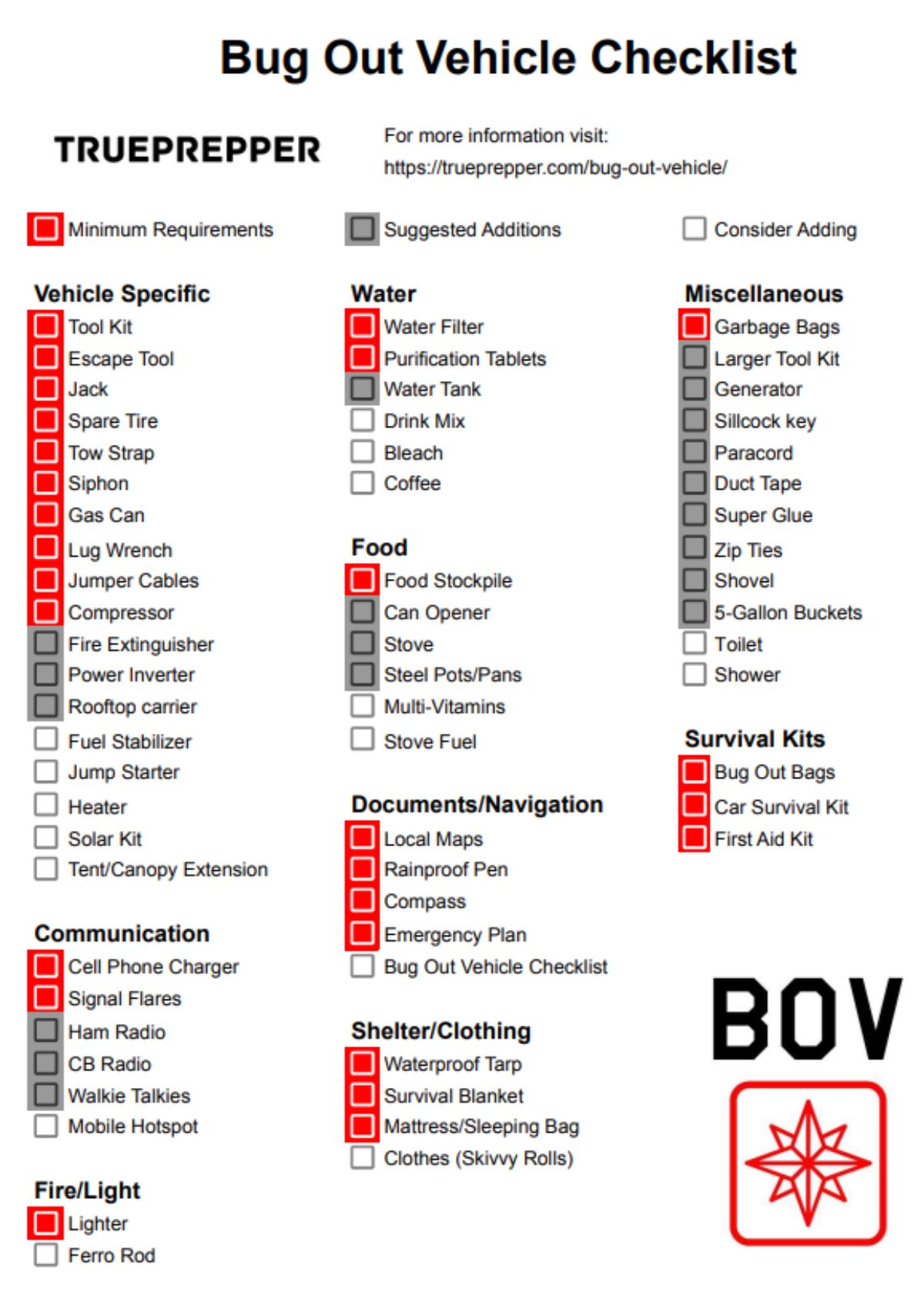
Bug Out Vehicle Printable PDF Checklist
If you are looking for the simplest way to print and use the checklist above, download our printable PDF version. It is one page long on 8.5″ x 11″ paper and makes outfitting your bug out vehicle extremely easy. Once you open the bug out vehicle PDF checklist in your browser, you can either print it directly or save it through your browser.
Bug Out Vehicle Checklist Excel / Google Sheet
If you are looking for a comprehensive way to plan and track your bug out vehicle contents, open our Excel / Google Sheets version. The sheet is sharable, and you just need to copy it to your own Google Sheets account or download it to Excel to edit it. We also keep the reviews for each category item linked to simplify shopping for any equipment you may find yourself missing.
Bug Out Vehicle Gear
Gear for your bug out vehicle has a lot of overlap with your bug out bag and your basic car survival kit. You can use those guides to find gear related to our recommendations in the checklist:
Rounding Out Your Bug Out Plan
A bug out vehicle is meant to get you with your bug out bag to a predetermined bug out location. If you don’t have a bug out location, you have more of an “I’m Never Coming Home” plan and you’ll need more INCH equipment to sustain yourself for longer.
We cover INCH in our INCH bag guide, but you can easily adapt it to your BOV with a little extra planning.
The Final Word
Movies are a great way to kick back and relax, and movies with prepping and survival elements can be both entertaining and enlightening. Our favorites include movies that show possible disaster events and survival situations, and how the protagonists choose to navigate them.
Here are a few other guides our subscribers have found helpful:
- 11 Prepping Mistakes to Avoid
- Car Survival Kit Guide, Tips, and Checklist
- Bug Out Bag List | 44 Essentials
Keep exploring, stay prepared, and be safe.
You’ve Been Missing Out
Join the 2+ million preppers that rely on our prepping advice by subscribing to TruePrepper.- Practical guides and tips
- Useful survival giveaways
- Free, forever
- < 0.4% of people unsubscribe
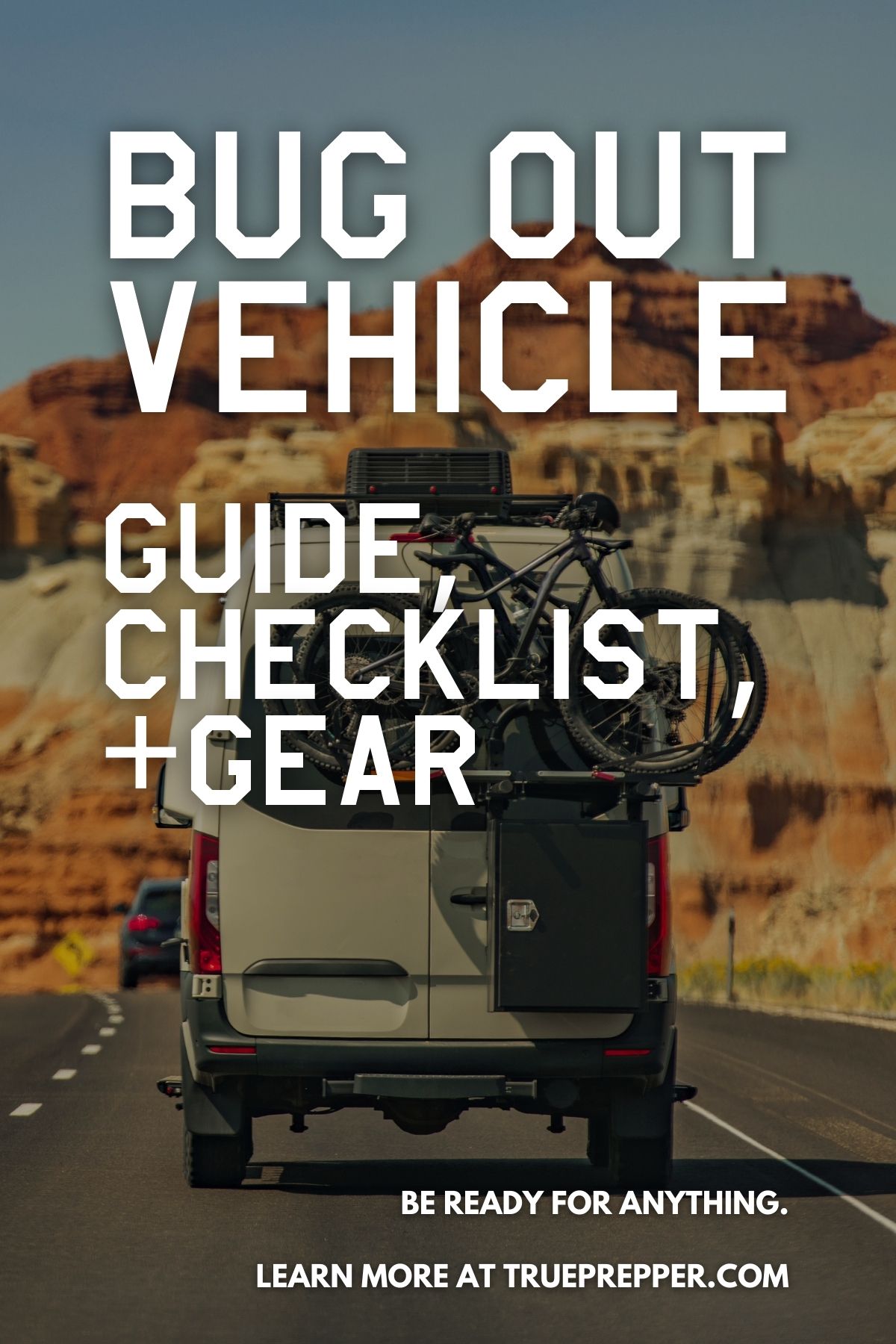

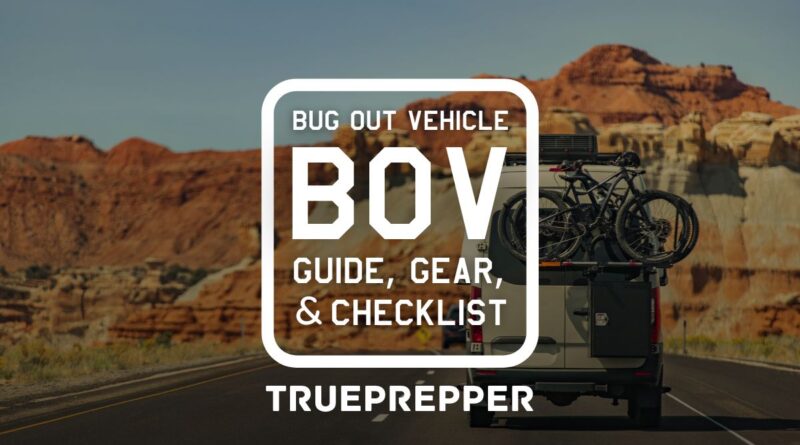
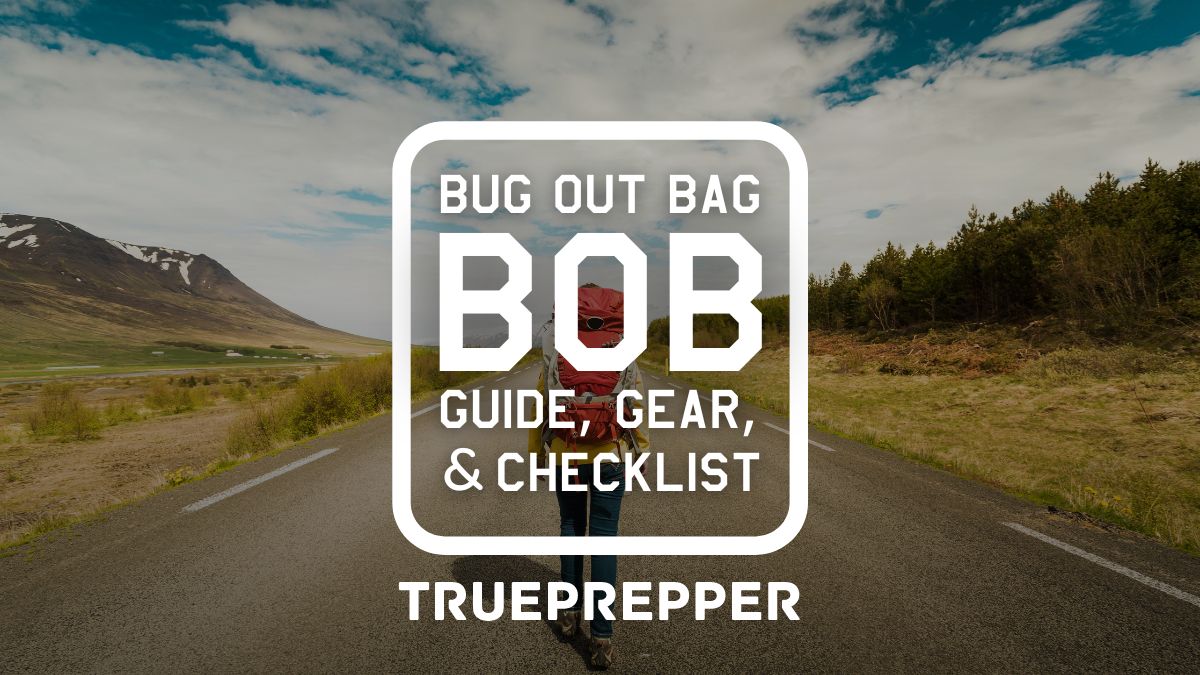
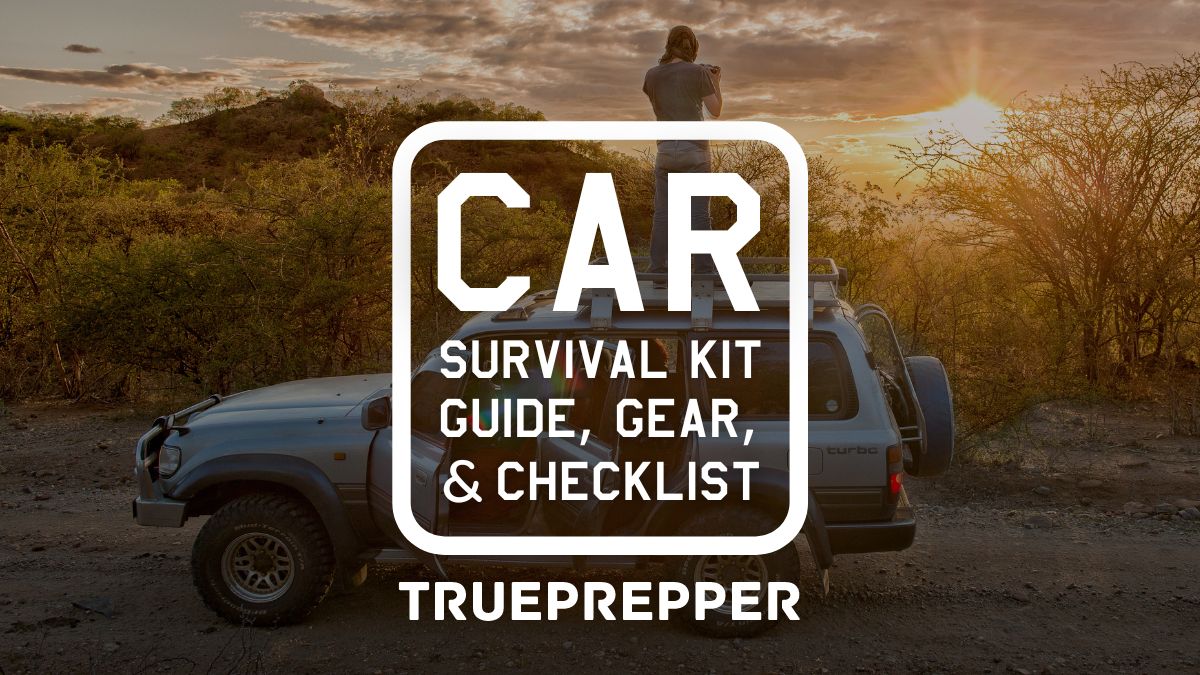
Thank you for the quick informative emails once a week. Good info, good subjects, well done, and not slammed everyday with emails.
I have a “camping list” to add to your inventory. How can I get it to you?